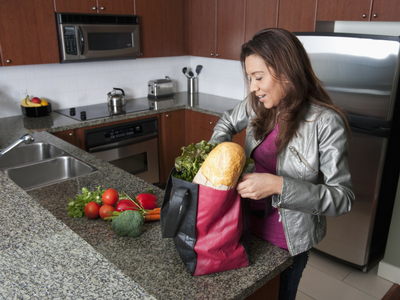Can we just agree that eating healthy on a consistent basis can be tricky? As a matter of fact, it can feel like mission impossible. As long as life is going smoothly, it doesn’t seem to be a struggle to purchase, download or create a meal plan, and to stick to it. But, when our schedules get busy or we’re hit with unanticipated challenges, it all goes out the window. We get stuck in this cycle of starting, stopping, and mustering up the energy to start again.
The longer we do this, the easier it becomes to feel disappointed, ashamed, and even doubtful that we will ever create consistency with healthy eating.
 Earlier in my healthy eating journey, I tried my hardest to fit the mold instead of creating my own mold. Maybe like you, I felt like I needed to follow a checklist of rules or a meal plan from a coach. To be honest, whenever I followed the rules or a plan, I did achieve the results that I wanted at first. However what I never achieved with this approach was lasting consistency.
Earlier in my healthy eating journey, I tried my hardest to fit the mold instead of creating my own mold. Maybe like you, I felt like I needed to follow a checklist of rules or a meal plan from a coach. To be honest, whenever I followed the rules or a plan, I did achieve the results that I wanted at first. However what I never achieved with this approach was lasting consistency.
I couldn’t maintain my eating approach because I had to either give up my favorite foods to be on plan or save them for “cheat days.” This created so much anxiety around food that I started eating worse than before. I was either following the plan to the letter or going completely off the rails. And when I went off the rails, I would quickly notice a difference in how I felt and how I was moving towards my goals. Worst of all was the amount of shame that I would feel for not being able to just stick to the plan.
I failed to see the real problem — that the plan wasn’t working. Instead, I erroneously believed that I needed more willpower.
The truth was that I needed to stop trying to follow the plan and finally create my own.
 So many of us approach healthy eating and meal planning with a blank slate. We look to experts and coaches to tell us which foods are healthy and what to avoid. Then, we attempt to create daily meals from those recommendations. In most cases, the foods aren’t ones we’d normally eat. We aren’t excited about our meals beyond the results that we hope they’ll produce. So, even the most motivated among us eventually quit following the plan.
So many of us approach healthy eating and meal planning with a blank slate. We look to experts and coaches to tell us which foods are healthy and what to avoid. Then, we attempt to create daily meals from those recommendations. In most cases, the foods aren’t ones we’d normally eat. We aren’t excited about our meals beyond the results that we hope they’ll produce. So, even the most motivated among us eventually quit following the plan.
What most of us overlook is that the answer to finally being consistent is to keep eating what we’re already eating — but with a few simple tweaks.
Here’s how you leverage the consistency that you already have with eating the foods that you love to become consistent with healthy eating.
Recognize the Basic Components of a Healthy Meal
No matter what outcome you hope to produce with your style of eating, the components of a healthy meal are the same across goals. The amounts of each one in a meal may change but the components don’t. Those components are protein, vegetables, starch, fat, and water.
 A healthy meal starts with a source of protein. Protein in a meal helps you to feel fuller longer and helps your muscles recover from exercise. Next, you include a source of vegetables. You may not choose to include a vegetable at every meal. However, getting at least three servings of vegetables in a day can be helpful in controlling your hunger, promoting regular elimination, and creating an overall feeling of well-being.
A healthy meal starts with a source of protein. Protein in a meal helps you to feel fuller longer and helps your muscles recover from exercise. Next, you include a source of vegetables. You may not choose to include a vegetable at every meal. However, getting at least three servings of vegetables in a day can be helpful in controlling your hunger, promoting regular elimination, and creating an overall feeling of well-being.
While most of us can feel full after eating a meal that only contains meat and vegetables, many of us won’t feel satisfied. I can remember following a competition-style diet and having to eat chicken and broccoli for my last meal. I was rarely ever still hungry after the meal. The protein and fiber were enough to make me feel full. However, I was never satisfied. And many times I would munch on snacks to fill the gap — not the plan at all! That’s where including a source of starch or fat could help.
Protein and vegetables are the fullness factors in a meal. However, starch and fat are the satisfaction factors. Whether starch or fat is going to be most satisfying is highly individual. You’ll need to experiment a bit to figure out which one works best for you. However, if one of your goals is to lose body fat or maintain your current body composition, you’ll likely benefit from including a serving of one or the other.
 For instance, you may be planning on making Italian chicken with potatoes and spinach for dinner. In this meal, the protein and vegetables are the chicken and spinach, while the potato is the starch. If you’re someone who feels most satisfied from fat rather than starch, you could change this meal to include a source of fat instead of starch, by choosing to make Italian chicken with creamed spinach, for example.
For instance, you may be planning on making Italian chicken with potatoes and spinach for dinner. In this meal, the protein and vegetables are the chicken and spinach, while the potato is the starch. If you’re someone who feels most satisfied from fat rather than starch, you could change this meal to include a source of fat instead of starch, by choosing to make Italian chicken with creamed spinach, for example.
Assess Your Current Meals
Now that you recognize the components of a healthy meal, it’s time to assess the meals you already eat to see if they contain all the components you’re looking for. Remember, you are already consistent in eating these. So we’re just optimizing the meals so that your consistency is paying off in terms of the results you want.
Here’s an example of how you could assess one of your current meals again the standard (remember that you’re looking for protein, vegetables, water, starch and fat). Let’s say that one of your go-to meals is a chicken, rice and bean burrito, with guacamole and a soft drink. Your assessment would look like this:
- There is a source of protein.
- There aren’t any vegetables.
- There isn’t any water but there is a sugary drink.
- There is quite a bit of starch — definitely more than a serving.
- There’s also a source of fat — likely more than a serving.
Optimize Your Current Meals
 Optimizing your current meals may mean that you need to add missing components, or that you change portions or eliminate other components altogether. If we keep going with the example above, we want to get a full serving of protein, possibly include vegetables, decrease the amount of starch and keep the fat content at a lower level (assuming we’re going to choose starch as the satisfaction factor).
Optimizing your current meals may mean that you need to add missing components, or that you change portions or eliminate other components altogether. If we keep going with the example above, we want to get a full serving of protein, possibly include vegetables, decrease the amount of starch and keep the fat content at a lower level (assuming we’re going to choose starch as the satisfaction factor).
One option for how we can make that happen is replacing the burrito with a chicken fajita salad with rice, and the soft drink with sparkling water.
Now we have a complete serving of protein and a source of vegetables. We have a complete serving of rice rather than four or five servings of starch between the rice, beans, and tortilla. And, we can choose to drink water or a flavored sparkling water instead of the soft drink. Finally, we can drizzle on a little dressing without adding a significant amount of fat. With the same effort and similar taste, we’ve created a healthy meal that we can actually enjoy without any extra effort on our part.
Create Your Reverse Menu Plan
It’s great to know how to build a healthy meal from foods you already love. However, it’s far more powerful to have an entire menu of options to eliminate the stress that comes with practicing this new skill in real time.
At this point, creating a menu plan that you can enjoy and will stick to over time is easy. Simply, run three or four of your most common breakfast, lunch, dinner, and snack options through the assessment process. Next, tweak them to include the components of a healthy meal. When you’re done, you have a customized menu plan full of healthy meals that you love.
There’s no bigger consistency trigger than actually enjoying the meals you eat while getting the results you want.
 Now you may be wondering whether or not you need to pair specific meals together in a day for even better results. You may feel like this is way too simple to work.
Now you may be wondering whether or not you need to pair specific meals together in a day for even better results. You may feel like this is way too simple to work.
Here’s the deal: the reason why this works is because it is simple. You will spend the same amount of time that you already spend to cook or order your meals. No gearing up for to follow a new meal plan. No carving out extra time to learn the recipes or prep new food. However, there may come a time when which meals you combine in a day does matter. If you aren’t already consistently eating healthy, that time isn’t now.
We can never optimize what we’re not consistently doing.
So, this is the first step. Try this, get really good at it, and then decide if you need or want to put in more effort to fine tune things even more. What I’ve found is that most of my clients feel great and get the results that they want with this step alone.
And, they do so while still having plenty of time to live their lives outside of menu planning and food prep. In the end, that’s really the point isn’t it?
Source Link – https://www.girlsgonestrong.com/blog/nutrition/how-to-achieve-healthy-eating-consistency-with-reverse-meal-planning/





